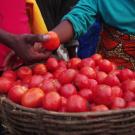The Reducing postharvest losses in Rwanda project, led by Gurbinder S. Gill of Agribusiness Associates Inc., has evaluated storage methods on various crops: tomatoes, hot chilies, cooking bananas, and carrots. The summary of the project and results for tomatoes is shared below.
Methodology: testing tomatoes with different storage methods
To study the effects of different storage methods on tomatoes, round, full, feel heavy for their size, and free of bruises or blemishes fruits were collected from the farms and transported in plastic crates or perforated polyethylene bags to a storage location. For each storage methods, fruits were arranged randomly into 3 groups, each with 6 pieces. The storage methods used were: open-air, perforated plastic sachet, zero-energy cool chamber (ZECC), and cold room. Fruits were stored until they appeared not attractive for the market or consumption. Photos were taken at the end of each day to record changes in - color, softening, rotting, darkening, and shape. Additionally, weight, average pulp temperature, and relative humidity were recorded during morning, afternoon, and evening of each day through the study period.
Results: cooler storage keeps tomatoes longer
The respective days for shriveling and rotting of tomatoes were: 2 and 5 days for open-air, 2 and 7 days for perforated plastic sachet, 4 and 8 for closed plastic sachet, 4 and 7 days for ZECC, and 6 days and no rotting for cold storage. The weight loss observed was: 32.4% for open-air, 6% for perforated plastic sachet, 2.5% for closed plastic sachet, 6.5% for ZECC, and 2.7% for cold room. Signs of deterioration were: rotting and decay.
Recommendations: store tomatoes in cool, dark conditions
Store fresh ripe tomatoes in cool, dark place with stem side down and use within few days. Optimal storage temperatures depend on the maturity stage of the tomatoes. Ideal conditions for ripening are 19-21°C and 90-95% relative humidity. Storage >27°C reduces intensity of red color, storage <13°C retards ripening and can lead to development of chilling injury, particularly in tomatoes at the mature-green stage. Red tomatoes can be stored at 7°C for a couple of days; tomatoes stored at 10°C can be rated lower in flavor and aroma than those held at 13°C.

